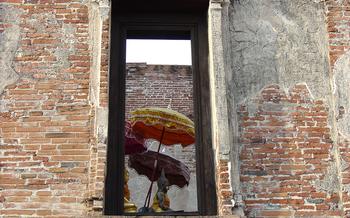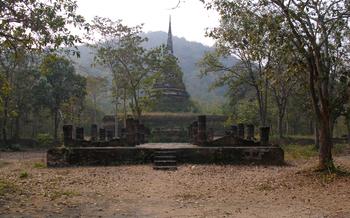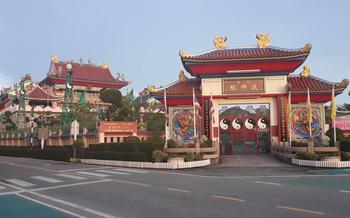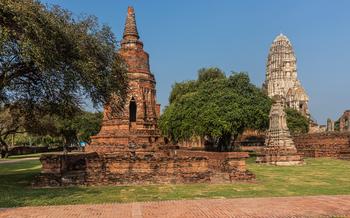
Wat Phikun Thong
- Exploring the Grounds
- Paying Respects at the Main Shrine
- Marveling at the 13-Tiered Chedi
- Discovering the Minor Shrines
- Witnessing the Daily Monk Chants
- Exploring the Temple Museum
- Learning about Herbal Medicine
- Attending a Meditation Retreat
- Volunteering at the Temple
- Exploring Nearby Attractions
- Insider Tip: Unveiling Hidden Treasures
Exploring the Grounds
Wat Phikun Thong's sprawling grounds are a treasure trove of architectural wonders and serene spaces. As you step through the temple's gates, you'll be greeted by a beautifully landscaped courtyard adorned with colorful flower beds and towering trees. The temple's layout is designed to promote a sense of tranquility and invites visitors to explore its many hidden corners.
Among the must-see areas within the complex is the ordination hall, known as the 'bot'. This grand structure is supported by intricately carved pillars and features a stunning mural depicting scenes from the life of Buddha. The walls are adorned with vibrant paintings that narrate various Buddhist tales and legends.
Another highlight is the 'viharn', or assembly hall. This spacious hall houses several Buddha images, including a particularly revered one known as 'Luang Pho To'. Devotees often come here to pay their respects and offer prayers. The viharn is also used for religious ceremonies and meditation sessions.
As you wander through the temple grounds, take some time to admire the numerous sculptures and stupas that adorn the landscape. Each piece of art has a unique story to tell, and you'll find yourself drawn into the rich symbolism and craftsmanship that is characteristic of Thai Buddhist temples.
During my visit, I had the pleasure of meeting a friendly monk who shared fascinating insights into the temple's history and significance. He explained the symbolism behind the various architectural elements and sculptures, bringing the temple's stories to life.
Paying Respects at the Main Shrine
At the heart of Wat Phikun Thong stands the revered main shrine, a sanctuary of devotion and reverence. Enshrined within is the magnificent Buddha image, a testament to the temple's sacred history. Believed to date back to the Ayutthaya period, the image exudes an aura of serenity and compassion, inviting pilgrims from near and far to seek solace and blessings.
Before approaching the shrine, visitors are expected to observe traditional customs as a sign of respect. Removing footwear and dressing modestly is a must. Upon entering the shrine, a palpable sense of tranquility envelops the atmosphere. Devotees kneel or sit in a respectful posture, offering prayers and making merit through offerings of lotus flowers, incense sticks, and candles.
One particularly touching anecdote is that of a young woman named Araya, who had long been struggling with personal challenges. Driven by her unwavering faith, she made a pilgrimage to Wat Phikun Thong, seeking solace and guidance. As she knelt before the main Buddha image, she poured out her heart, whispering her deepest desires and aspirations. Days later, to her astonishment, her prayers were answered in the most unexpected way, reinforcing her belief in the temple's sacred power.
Marveling at the 13-Tiered Chedi
Rising majestically within the temple complex, the 13-tiered chedi stands as an awe-inspiring symbol of Wat Phikun Thong's grandeur. Constructed in the early 19th century, this architectural masterpiece is a testament to the ingenuity and craftsmanship of the temple's builders. Each tier of the chedi is adorned with intricate carvings and sculptures, depicting mythological creatures, scenes from Buddhist mythology, and tales of Thai folklore. The chedi's unique design, with its gradually diminishing tiers, creates an illusion of height and adds to its imposing presence. Visitors can climb the chedi's narrow staircase, which winds its way through the tiers, offering breathtaking views of the surrounding countryside. From the top of the chedi, one can marvel at the temple's sprawling grounds, the nearby rice fields, and the distant hills, creating a panoramic vista that is simply unforgettable.
One evening, as the sun began to set, I had the privilege of witnessing a magical sight from the chedi's summit. The sky was ablaze with hues of orange, purple, and pink, casting a warm glow on the temple complex. As the sun dipped below the horizon, the chedi transformed into a silhouette against the vibrant sky, its tiers resembling a staircase leading up to heaven. The sight was so captivating that I found myself lost in contemplation, marveling at the beauty of nature and the majesty of this sacred place.
Discovering the Minor Shrines
Wat Phikun Thong is home to a myriad of smaller shrines dedicated to various deities and spirits. These shrines, often adorned with intricate carvings and colorful offerings, provide a glimpse into the diverse beliefs and practices of Thai Buddhism.
One of the most prominent minor shrines is dedicated to the revered monk Luang Pu Thuat. Believed to possess supernatural powers, Luang Pu Thuat is widely revered for his ability to perform miracles and protect his devotees. Visitors often pay homage at his shrine, seeking blessings and guidance in their lives.
Another notable shrine is dedicated to the goddess Kuan Yin, also known as the Goddess of Mercy. Symbolizing compassion and kindness, Kuan Yin is a popular figure in Chinese Buddhism and is often sought after for protection and healing.
Additionally, there are shrines dedicated to the Hindu god Ganesha, the god of wisdom and good fortune, and the animist spirit Chao Mae Tuptim, who is believed to bring good luck and prosperity.
Each shrine holds its significance and is associated with unique beliefs and rituals. Visitors are encouraged to explore these minor shrines and learn about the diverse spiritual practices that coexist within the temple complex.
Witnessing the Daily Monk Chants
Every morning and evening, the air at Wat Phikun Thong resonates with the melodious chanting of monks. These sacred chants, known as "Suttas," are an integral part of the temple's daily routine and offer a deeply spiritual and serene experience to visitors.
The monks gather in the main prayer hall, adorned in their saffron robes, and begin their rhythmic recitation of the Suttas. The chanting is accompanied by the gentle tapping of wooden clappers, creating a hypnotic and meditative atmosphere.
As a visitor, it is customary to observe silence and show respect during the chanting session. You can either sit in the prayer hall alongside the monks or find a quiet spot within the temple complex to listen.
Anecdote:
During my visit to Wat Phikun Thong, I had the privilege of witnessing the daily monk chants. As I sat in the prayer hall, surrounded by the harmonious chanting, I felt a sense of tranquility wash over me. The melodic voices of the monks seemed to transport me to a higher realm, and I couldn't help but feel a deep connection to the spiritual essence of the temple. It was a truly unforgettable experience that left me with a sense of peace and serenity.
Exploring the Temple Museum
Within the sacred grounds of Wat Phikun Thong lies a treasure trove of knowledge and history, housed in the temple museum. This repository of cultural artifacts and exhibits offers a captivating glimpse into the temple's rich past and its significance in Thai culture.
As you step into the museum, you are greeted by an array of ancient Buddha images, each with its own unique story to tell. From the serene countenance of the seated Buddha to the intricate details of the standing Buddha, these sculptures showcase the artistry and devotion of past generations.
Among the highlights of the museum is a collection of ancient manuscripts and scriptures, meticulously preserved and protected. These manuscripts provide a glimpse into the teachings and practices of Buddhism, shedding light on the temple's role as a center of spiritual learning and enlightenment.
Another fascinating exhibit showcases the traditional Thai musical instruments used in temple ceremonies and rituals. From the melodious sounds of the khene to the rhythmic beats of the drums, these instruments bring to life the vibrant soundscape of Thai temple culture.
The museum also houses a collection of artifacts that provide insight into the daily lives of the monks and the local community. From simple tools and utensils to ornate ceremonial objects, these items offer a tangible connection to the temple's rich history.
As you wander through the museum, you can't help but feel a sense of awe and reverence for the legacy of Wat Phikun Thong. Each exhibit tells a story, each artifact holds a piece of the temple's journey through time. It is a place where history comes alive, inviting visitors to delve deeper into the heart and soul of this sacred sanctuary.
Learning about Herbal Medicine
Wat Phikun Thong is renowned for its traditional Thai herbal medicine practices. Visitors can delve into the world of Thai herbal remedies through workshops and classes offered at the temple. These sessions provide insights into the ancient healing techniques and the use of natural ingredients to promote well-being. Participants learn about the properties of various herbs, their medicinal applications, and how to create their own herbal remedies.
One particular anecdote stands out in my memory. During my visit, I had the opportunity to attend a herbal medicine class taught by a knowledgeable monk. He shared his wisdom about the healing powers of herbs and demonstrated how to prepare a simple herbal tea blend. I was amazed by the depth of his knowledge and the simplicity of the remedies he shared.
After the class, I decided to try my hand at making my own herbal tea using the herbs I had purchased from the temple's herbal shop. To my surprise, the tea was not only delicious but also had a noticeable calming effect. I felt energized and refreshed, and I couldn't help but marvel at the power of nature's healing touch.
If you're interested in learning more about traditional Thai herbal medicine, Wat Phikun Thong is an excellent place to start. The temple's classes and workshops offer a unique opportunity to gain insights into this ancient healing tradition and experience the benefits of natural remedies firsthand. Whether you're a seasoned herbalist or simply curious about alternative medicine, I highly recommend taking advantage of this enriching experience.
Attending a Meditation Retreat
Wat Phikun Thong offers the unique opportunity for visitors to delve deeper into their spiritual journey through meditation retreats. These retreats, held periodically throughout the year, provide a serene and conducive environment for participants to learn and practice various meditation techniques. Whether you're a seasoned meditator or a complete beginner, these retreats offer a transformative experience that can help you cultivate inner peace, clarity, and mindfulness.
During a typical retreat, participants will engage in guided meditation sessions, learn about the principles of mindfulness, and receive teachings from experienced meditation masters. The temple's tranquil surroundings, surrounded by lush greenery and the gentle sounds of nature, create an ideal setting for contemplation and self-discovery.
One unforgettable anecdote from a meditation retreat at Wat Phikun Thong comes from a participant named Sarah. A long-time practitioner of yoga and mindfulness, Sarah had always been intrigued by the deeper aspects of meditation. During her retreat at the temple, she experienced a profound sense of tranquility and connection with herself. Through the guidance of the meditation masters, she learned to let go of distractions, quiet her mind, and access a deeper level of awareness.
Sarah recalls a particularly transformative moment during a guided meditation session. As she focused on her breath and let go of all expectations, she felt a sense of lightness and expansion within her. It was as if she had stepped into a vast and boundless space of pure consciousness. The experience left her with a lasting sense of peace and serenity that she carried with her long after the retreat had ended.
For those seeking a deeper connection to their inner selves, a meditation retreat at Wat Phikun Thong is a truly enriching and transformative experience. Whether you're looking to learn new meditation techniques, deepen your practice, or simply find a moment of respite from the busyness of life, the temple's serene atmosphere and expert guidance will provide you with a profound and unforgettable journey.
Volunteering at the Temple
Wat Phikun Thong welcomes visitors who wish to give back to the community and contribute to the temple's upkeep through volunteering. There are various opportunities for visitors to get involved, depending on their skills and interests.
One popular way to volunteer is to assist with the temple's daily operations. This can involve tasks such as cleaning and maintaining the temple grounds, helping with offerings and donations, or assisting with the preparation of food for monks and visitors.
Visitors with a green thumb can volunteer in the temple's extensive gardens, where they can help with planting, weeding, and maintaining the beautiful flowerbeds and trees.
For those interested in cultural preservation, there are opportunities to help with the restoration and maintenance of the temple's historic buildings and artifacts. This may involve tasks such as cleaning and polishing statues, repairing old structures, or assisting with the organization of the temple's museum.
Volunteering at Wat Phikun Thong is a rewarding experience that allows visitors to immerse themselves in the temple's community and contribute to its ongoing preservation. It's a great way to learn more about Thai culture, make new friends, and make a positive impact on the temple and its visitors.
Exploring Nearby Attractions
Beyond the confines of Wat Phikun Thong, a world of hidden gems awaits exploration. Just a short distance away, you'll find the serene beauty of Wat Phra Buddha Chai, another ancient temple known for its intricate murals and stunning Buddha images. History buffs will delight in exploring the nearby Prasat Hin Phimai, an impressive Khmer temple complex that rivals the grandeur of Angkor Wat.
Nature enthusiasts can immerse themselves in the lush greenery of the Khao Yai National Park, a UNESCO World Heritage Site home to diverse wildlife, including elephants, tigers, and gibbons. For a refreshing dip, head to the crystal-clear waters of the Nam Phut Natural Spring, a popular spot for locals and visitors alike.
To truly soak in the local culture, don't miss the vibrant Pak Chong Night Market, a bustling bazaar offering an array of street food, handicrafts, and souvenirs. Sample the region's culinary delights, from spicy som tum to mouthwatering grilled meats, and immerse yourself in the lively atmosphere of this vibrant market.
Insider Tip: Unveiling Hidden Treasures
Venture beyond the main temple grounds and explore the secluded corners of Wat Phikun Thong to uncover hidden gems. One such secret spot is the serene lotus pond, nestled amidst lush greenery. Take a moment to admire the vibrant blooms and listen to the gentle ripple of water, creating a tranquil oasis away from the bustling crowds.
For those seeking a unique spiritual experience, inquire about the ancient ritual of "luk krueng," a traditional Thai fortune-telling practice. Engage with the temple's fortune tellers, who will guide you through the process of selecting sacred objects that reveal insights into your destiny and offer guidance for the future.
Indulge in the local delicacy of "khao soi," a northern Thai curry noodle dish, at one of the nearby street stalls. Savor the rich flavors of coconut milk, aromatic spices, and tender noodles, topped with crispy wontons. This culinary delight is sure to tantalize your taste buds and leave you craving more.
As you explore the temple complex, keep an eye out for the elusive "white elephant," a symbol of good luck and prosperity in Thai culture. It is said that catching a glimpse of this majestic creature brings blessings and fortune. Embrace the magic and mystery of Wat Phikun Thong, and let its hidden wonders enhance your journey of exploration and discovery.






